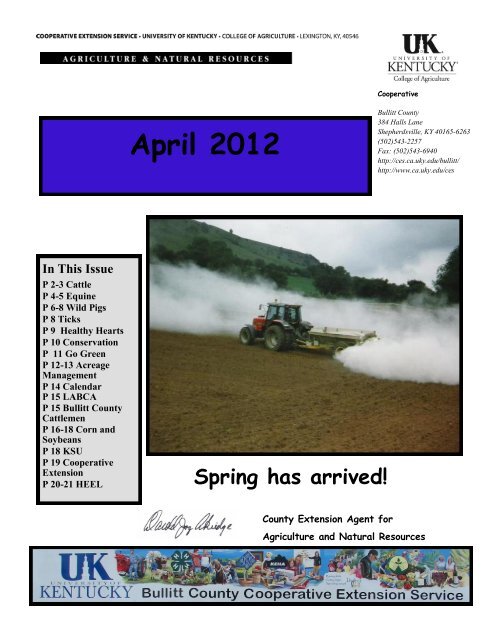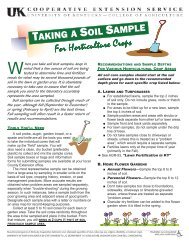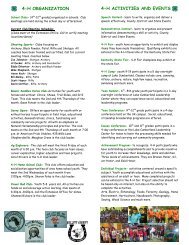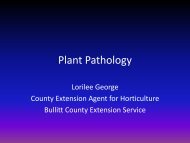2012 April Newsletter - Bullitt County Cooperative Extension
2012 April Newsletter - Bullitt County Cooperative Extension
2012 April Newsletter - Bullitt County Cooperative Extension
Create successful ePaper yourself
Turn your PDF publications into a flip-book with our unique Google optimized e-Paper software.
<strong>Cooperative</strong><br />
<strong>April</strong> <strong>2012</strong><br />
<strong>Bullitt</strong> <strong>County</strong><br />
384 Halls Lane<br />
Shepherdsville, KY 40165-6263<br />
(502)543-2257<br />
Fax: (502)543-6940<br />
http://ces.ca.uky.edu/bullitt/<br />
http://www.ca.uky.edu/ces<br />
In This Issue<br />
P 2-3 Cattle<br />
P 4-5 Equine<br />
P 6-8 Wild Pigs<br />
P 8 Ticks<br />
P 9 Healthy Hearts<br />
P 10 Conservation<br />
P 11 Go Green<br />
P 12-13 Acreage<br />
Management<br />
P 14 Calendar<br />
P 15 LABCA<br />
P 15 <strong>Bullitt</strong> <strong>County</strong><br />
Cattlemen<br />
P 16-18 Corn and<br />
Soybeans<br />
P 18 KSU<br />
P 19 <strong>Cooperative</strong><br />
<strong>Extension</strong><br />
P 20-21 HEEL<br />
Spring has arrived! Ar-<br />
<strong>County</strong> <strong>Extension</strong> Agent for<br />
Agriculture and Natural Resources
Page 2<br />
Cattle<br />
Spring calving herd<br />
Prepare for breeding season<br />
<br />
<br />
<br />
<br />
<br />
<br />
<br />
<br />
<br />
Have a veterinarian perform breeding<br />
soundness evaluations on bulls.<br />
Line-up AI services and/or purchase<br />
replacement bulls at least 30 days<br />
prior to the start of the breeding season.<br />
Choose a breed and use EPDs and<br />
visual observation to select the bull<br />
that best fits your programs’ goals.<br />
If you are going to use artificial insemination<br />
and/or estrus synchronization,<br />
make plans now and order<br />
needed supplies and semen.<br />
Male final selection of heifer replacements<br />
based on weight, pelvic<br />
size, and reproductive tract score.<br />
Spring or “turn-out” working is usually<br />
scheduled for late <strong>April</strong> or May.<br />
Consult your veterinarian about vaccines<br />
and health products your herd<br />
needs.<br />
Continue providing magnesium in<br />
the mineral mix until daytime temperatures<br />
are consistently above 60<br />
degrees.<br />
Identify calf with eartag and/or tattoo<br />
while calves are young and easy to<br />
handle and record dam and birth<br />
date.<br />
Commercial male calves should be<br />
castrated and implanted according to<br />
product recommendations.<br />
<br />
Registered calves should be weighed<br />
during the first 24 hours.<br />
Fall calving herd<br />
<br />
<br />
<br />
Pregnancy check the cow herd if not<br />
done previously.<br />
Finish vaccinations of calves.<br />
Calves intended for feeders can be re<br />
-implanted.<br />
Obtain cow and calf weights at weaning<br />
and see your <strong>County</strong>\<strong>Extension</strong> Agent<br />
for information on record keeping programs.<br />
Cull cows based on performance<br />
and pregnancy status and make<br />
initial heifer selections, keeping more<br />
than you intend to retain for the next<br />
breeding season,<br />
Considerations for all Cattle<br />
Continue supplemental feeding as needed.<br />
Forages<br />
<br />
<br />
<br />
<br />
Complete seeding of alfalfa.<br />
Determine need for supplemental<br />
forages such as millet or sudangrass.<br />
Prepare for start of hay harvest.<br />
Prepare fencing and water for grazing<br />
season and begin to graze early<br />
pastures. Plant corn for silage and<br />
warm season grasses after risk of<br />
frost.<br />
Source: <strong>2012</strong> Beef Integrated Resource<br />
Management Calendar , University of Kentucky
Page 3<br />
Parts of a cow.<br />
Do you know which<br />
part produces your favorite<br />
cut of meat
Page 4<br />
Horses<br />
Spring seeding of Legumes.<br />
Clover can still be seeded into your pasture<br />
until about <strong>April</strong> 15. At this time it<br />
would be best to no till the seed. Remember,<br />
when no tilling clover, it<br />
should only be no tilled about 1/4 inch<br />
deep.<br />
Mineral and Salt on Pasture<br />
<br />
<br />
<br />
<br />
<br />
Put mineral and salt products in a<br />
suitable feeder that is protected from<br />
the elements.<br />
Place feeder for easy access to your<br />
horse.<br />
Check for consumption. Regular<br />
consumption should be 1 to 1 1/2<br />
ounces per adult horse per day. The<br />
amount may vary depending on animals<br />
sweating.<br />
Use only products designed for<br />
horse.<br />
Use loose product to promote greater<br />
intake than with block products.<br />
Pasture Rotation<br />
<br />
<br />
<br />
<br />
Divide pastures into smaller paddocks<br />
to help reduce or eliminate selective<br />
grazing resulting in more<br />
complete utilization of available forage.<br />
Graze one paddock at a time.<br />
Move animals to the next paddock<br />
when forage is down to 3 to 4 inches.<br />
Return horses once the forage has<br />
returned to a height of 6 to 8 inches,<br />
which is normally after 2 to 3<br />
weeks.<br />
Composting converts organic matter<br />
into a stable humus-like material with<br />
a texture and color similar to peat moss<br />
or potting soil.<br />
Compost Unused Hay/Bedding<br />
A typical horse weighing 1,000 pounds<br />
will produce approximately 50 pounds<br />
of manure per day, and horses housed in<br />
stalls may generate an additional 20<br />
pounds of soiled bedding per day. Improper<br />
management of this waste has<br />
the potential to pollute Kentucky’s surface<br />
and ground waters. Composting,<br />
when done correctly, is a viable option.<br />
<br />
<br />
Turn compost piles or windrows.<br />
Aerobic (with oxygen) decomposition<br />
is more efficient than anaerobic<br />
and is achieved through aeration.<br />
Turn the pile 3 to 5 times every 2 to<br />
3 days when the moisture content is<br />
between 40 and 70 percent.<br />
Maintain temperatures between 135<br />
and 160 degrees. A temperature of<br />
150 degrees is ideal for killing the<br />
eggs of parasites.<br />
<br />
<br />
Apply stable compost to pastures,<br />
gardens, and around trees and shrubs<br />
as a mulch or soil amendment.<br />
Source: Equine Initiative <strong>2012</strong>/2013 Calendar,<br />
University of Kentucky
Page 6<br />
Wild Pigs in Kentucky<br />
Pigs have long been an element<br />
of rural life in Kentucky, though in recent<br />
years our favorite source for the<br />
“other white meat” has emerged as a<br />
new presence in our fields and forests.<br />
These free-ranging pigs have been given<br />
many names including razorbacks, rooters,<br />
and wild boar, but in truth they are<br />
little more than domestic pigs living independent<br />
of people. Correctly termed<br />
wild or feral pigs, this species is simply<br />
an exotic pest posing serious ecological,<br />
economical, and disease threats.<br />
If you have lived or spent much<br />
time in more southeastern states, you<br />
may be well acquainted with the ills of<br />
wild pigs. In fact, they have been present<br />
throughout much of the southeastern<br />
United States since the 1500s, descendants<br />
of domestic pigs accompanying<br />
early European explorers as livestock.<br />
Historic practices of allowing<br />
pigs to range freely and regular releases<br />
of pigs over the following centuries encouraged<br />
their spread. Moreover, in the<br />
first half of the 20th century Eurasian<br />
wild boar, the wild species from which<br />
pigs domesticated, were imported on<br />
several occasions to hunting preserves.<br />
Subsequent escapes from preserves and<br />
purposeful releases of Eurasian wild<br />
boar over the following decades, augmented<br />
local feral populations with<br />
which they freely interbred. Such interbreeding<br />
introduced “wild boar” physical<br />
characteristics into successive generations<br />
of wild pigs consistent with those<br />
regularly seen in modern populations.<br />
From the 1950s through the late 1970s<br />
additional movements and releases by<br />
private individuals and some state wildlife<br />
agencies further expanded the range<br />
of wild pigs in the southeast, establishing<br />
them as a popular game species in<br />
some states.<br />
In Kentucky, it is illegal to possess,<br />
transport, or release wild pigs, and<br />
a sanctioned release has never occurred.<br />
Nevertheless, wild pigs have been present<br />
in the Cumberland Plateau region<br />
of Tennessee since the 1960s, and their<br />
dispersal into Kentucky was first documented<br />
in 1988. Public reports of wild<br />
pigs in Kentucky remained relatively<br />
uncommon until the 1990s when sporadic<br />
reports began to emerge from the<br />
Dale Hollow Lake area of Cumberland<br />
<strong>County</strong> and the Big South Fork National<br />
River and Recreation Area in McCreary<br />
<strong>County</strong>. Today, verified sightings and<br />
documented hunter kills have been confirmed<br />
in approximately one-third of<br />
Kentucky’s counties. Clear disconnections<br />
between emerging wild pig populations<br />
have been created through illegal<br />
releases in an attempt by misguided individuals<br />
to create a recreational hunting<br />
opportunity.<br />
Regrettably, the establishment of<br />
wild pig populations is not difficult and<br />
has now occurred across Kentucky and<br />
in at least 45 states. The remarkable<br />
adaptability of this species has aided its<br />
spread across diverse habitats and climatic<br />
conditions.<br />
(Continued next page)
Page 7<br />
(Continued from previous page)<br />
Compound this adaptability with an incredible<br />
reproductive potential, and the<br />
problem is clear. Sows are capable of<br />
having two litters of greater than 10 piglets<br />
per year, and reproduction is not<br />
seasonally bound. In addition, juvenile<br />
pigs reach reproductive maturity by only<br />
6 to 10 months of age. Population<br />
growth can be explosive, and damage<br />
associated with pigs will increase simultaneously.<br />
Most Kentuckians are fortunate<br />
enough to have never seen or experienced<br />
wild pig damage, although the<br />
threats posed by this exotic pest should<br />
concern us all. In parts of the Commonwealth,<br />
farmers are experiencing crop<br />
depredation with reported losses in the<br />
tens of thousands of dollars; losses can<br />
be expected to increase as wild pig<br />
numbers grow. In addition, wild pigs<br />
are one of the most active carriers of<br />
wildlife-related disease, and at least 45<br />
parasites and diseases transmissible to<br />
livestock, pets, wildlife, and people<br />
have been identified. All threats posed<br />
by wild pigs are equally alarming, but it<br />
may be the ecological damage that hits<br />
closest to home for those of us who<br />
manage the land for wildlife or timber.<br />
Ecological damage related to wild<br />
pigs occurs both in the short and long<br />
term. Most conspicuous is the disruption<br />
to the ground and soil processes<br />
from pig rooting and wallowing behaviors.<br />
The voracious appetite of pigs has<br />
farther reaching impacts. Acorns and<br />
other hardwood mast represent a major<br />
food source for wild pigs; forest regeneration<br />
can be significantly altered in<br />
areas of high pig abundance as they<br />
may leave few seeds to germinate.<br />
Even tree seedlings are not safe from<br />
pigs and may be uprooted, trampled,<br />
and in some cases consumed. Sensitive<br />
or imperiled plant communities are particularly<br />
threatened by rooting, wallowing<br />
and trampling activities often resulting<br />
in irreversible damage. Faunal<br />
communities also suffer as native wildlife<br />
is often displaced by wild pigs<br />
through competition for food and space.<br />
Moreover, wild pigs are relatively indifferent<br />
in their forage selection and will<br />
consume most any available invertebrate<br />
or vertebrate prey including reptiles,<br />
amphibians, ground-nesting bird<br />
eggs, and even deer fawns.<br />
Relative to other states, wild pig<br />
number in Kentucky remain low, and<br />
properly implemented control is effective.<br />
Although rooting is the most recognizable<br />
sign that pigs are frequenting<br />
your property, several other tell-tale<br />
signs may be left by wild pigs. Tracks,<br />
rubs, hog wallows, droppings, beds, and<br />
trails may also be present if pigs are using<br />
your property. Look for these signs<br />
to determine the travel routes that pigs<br />
are using to access your property. Concentrating<br />
control efforts along these<br />
routes can significantly increase the<br />
success of your eradication efforts.<br />
The allure of hunting wild pigs<br />
has been one of the main factors in the<br />
spread of their populations, but hunting<br />
(Continued next page)
Page 8<br />
(continued from previous page)<br />
has been proven time and again to be<br />
ineffective in eliminating wild pig problems.<br />
Experience shows that when pigs<br />
are hunted they will do one of two<br />
things: become nocturnal or leave the<br />
property. This response to hunting is<br />
not beneficial to you or neighboring<br />
landowners. If you regularly see a lone<br />
pig on your property it is effective to<br />
shoot the animal, but if you are seeing<br />
multiple pigs, your best strategy is to<br />
establish corral traps around areas of<br />
abundant pig sign and intensively trap<br />
those animals. Hunting can then be<br />
used as an effective method on removing<br />
trap shy animals that remain in the<br />
area after you have exhausted your trapping<br />
efforts. Kentucky Department of<br />
Fish and Wildlife Resources private<br />
lands wildlife biologists are available to<br />
help you develop a management plan<br />
for trapping pigs on your property. Although<br />
trapping wild pigs can become<br />
expensive, the cost is far less that the<br />
economic impact of not controlling wild<br />
pig populations. Cost-share assistance<br />
is also available through the KDFWR<br />
Habitat Improvement Program. If you<br />
would like to learn more about trapping<br />
wild pigs or applying for cost-share assistance,<br />
please contact KDFWR headquarters<br />
at 1.800.858.1549, or visit our<br />
website.<br />
Source: “Wild Pigs in Kentucky”, Chad<br />
Soard and Jason Nally, “Kentucky Woodlands<br />
Magazine, Volume 6 Issue 3, University<br />
of Kentucky Department of Forestry and<br />
Kentucky Division of Forestry<br />
CONGRATULATIONS<br />
TO CLIFF KELLER<br />
FOR WINNING<br />
‘TEST YOUR KNOWLEDGE ‘<br />
Kentucky Woodland<br />
MAGAZINE<br />
Volume 6 Issue 2<br />
Be on the Lookout for Blacklegged<br />
Ticks!<br />
The blacklegged tick (Ixodes scapularis),<br />
also called the deer tick, is the<br />
main vector of Lyme disease (LD) in the<br />
northeastern US. While Lyme disease is<br />
established in the northeast, few cases<br />
have been reported in southern states<br />
and LD is not considered endemic here.<br />
However, it is important to be aware of<br />
possible increases in populations of this<br />
tick and to report finding in Kentucky.<br />
The blacklegged tick has been found at<br />
several locations in eastern Kentucky.<br />
Lay, Jackson, Knox, and McCreary<br />
counties) over the past few years, and<br />
most recently in Lee Co. All the found<br />
ticks have been adults, which are active<br />
from November through <strong>April</strong>. Given<br />
the potential health impact , it is important<br />
to be alert for it. Do not hesitate<br />
to send any ticks in for identification.<br />
Specimens representing new county records<br />
will be forwarded to the National<br />
Veterinary Services Laboratory in Ames,<br />
IA.<br />
Source: Kentucky Woodland Magazine
Page 9<br />
Paroquet Springs Conference Center was dressed in red for<br />
“Healthy Hearts” event on February 23, <strong>2012</strong>.
Page 10<br />
Winners of the <strong>2012</strong> Conservation Essay competition with their<br />
sponsor and Chairman of the <strong>Bullitt</strong> Conservation District, George<br />
Henderman at the awards banquet on February 28.<br />
<strong>April</strong> is National Food Month<br />
Celebrate National Food Month by enjoying a wide variety of<br />
Kentucky Proud meats, cheeses, fruits, vegetables and value-added<br />
products. See why they say “Kentucky Proud – nothing else is<br />
close.” Visit www.kyproud.com.<br />
Kentucky Proud, Kentucky’s official branding program, is administered<br />
by the Kentucky Department of Agriculture and supported by the<br />
Kentucky Agricultural Development Fund.
Page 11<br />
Farmer Incentives to Go Green for <strong>2012</strong><br />
First round deadline <strong>April</strong> 30<br />
FRANKFORT, Ky. (March 30, <strong>2012</strong>) – The Kentucky Agricultural Development<br />
Board (KADB), chaired by Governor Steve Beshear, reminds producers of<br />
the availability of $2 million in Kentucky Agricultural Development Funds<br />
(KADF) for on-farm energy efficiency or production projects. Application and<br />
guidelines for the KADB’s new On-farm Energy Efficiency & Production Incentives<br />
Program are available online at ag-energy.ky.gov.<br />
The program will provide 25 percent reimbursement of the actual cost of a qualified<br />
energy saving item, up to $10,000. Permissible items include, but are not<br />
limited to, energy audits, energy efficient farm building components, on-farm energy<br />
upgrades and on-farm energy efficiency training. Only expenditures made<br />
after March 11, 2011 will be eligible for reimbursement.<br />
All applications will be reviewed on a quarterly basis and scored by a committee<br />
comprised of representatives from GOAP, the Kentucky Agricultural Development<br />
Board, the University of Kentucky College of Agriculture and USDA Rural<br />
Development. The first quarterly deadline is <strong>April</strong> 30, <strong>2012</strong>.<br />
For questions about the program, please contact Bill McCloskey or Angie Justice<br />
at 502-564-4627 or govkyagpolicy@ky.gov.
Page 12<br />
ACREAGE MANAGEMENT<br />
TOOLS<br />
It is very important to know some<br />
guidelines and have the tools to<br />
manage your acreage. The ability<br />
to evaluate what you have and the<br />
knowledge to get what you want<br />
out of your acreage is your ultimate<br />
goal. The following are some<br />
tools to get you to where you want<br />
to be with your acreage.<br />
Step 1- Document What You<br />
Have-<br />
Property boundaries - who are<br />
your neighbors and how are they<br />
using their property (farming,<br />
ranching, dairy, junkyard, etc.)<br />
Utilities - both above and below<br />
ground and who provides these<br />
utilities.<br />
How the ground lays - direction<br />
and steepness of slopes and any<br />
out cropping (topographic map).<br />
Soil types - you can find this information<br />
by referring to your local<br />
county soil survey agency,<br />
maps are also available from the<br />
USDA Natural Resource Conservation<br />
Service office.<br />
Water features, if there are any<br />
present on your property. Ponds,<br />
streams, low wet areas or wetlands.<br />
Fences, corrals, buildings, roads,<br />
dumps, and underground storage<br />
tanks.<br />
Wells (human or stock), abandoned<br />
wells - get a well analysis<br />
done by a local driller to know the<br />
depth to ground water, pump capacity,<br />
and flow rate of the well.<br />
Also, get a water analysis done<br />
from a local testing agency (call<br />
your local NRCS office).<br />
Septic System – map the leach<br />
field and holding tank.<br />
Existing pastures.<br />
Livestock watering sites.<br />
Ditch easements.<br />
Map the vegetation (species and<br />
location).<br />
Rare and endangered species habitant.<br />
Land uses constraints, such as<br />
high water tables, flood potential.<br />
Access to your property.<br />
Check zoning, building codes and<br />
other regulations that govern land<br />
use in your area.<br />
Financial means to do what you<br />
want.<br />
Time-how much labor can you<br />
invest<br />
Equipment-tractor, sprayer, bushhog,<br />
manure spreader, etc.<br />
Step 2 - Vision...Goals….Action<br />
(Continued next page)
Page 13<br />
(continued from previous page)<br />
The best management plans have clear<br />
visions, goals and action steps.<br />
Vision: What are your dreams A vision<br />
is a dream written down. Your vision<br />
needs to be a family dream. Sit<br />
down and come up with general statements<br />
of where your efforts should go<br />
and what it will accomplish over a given<br />
time span (usually 5 to 10 years). A vision<br />
should be comprehensive enough<br />
to capture all of your desired visions<br />
and goals.<br />
Goals: Less general than visions and<br />
describes what is needed to achieve the<br />
vision.<br />
Action steps: Explains who is going to<br />
do what, where and when. They generally<br />
articulate how to implement the<br />
goals. Don’t try and do too much at one<br />
time, just one step at a time.<br />
NOMINATIONS: AMERICA ’S<br />
FARMERS MOM OF THE YEAR<br />
DEADLINE: <strong>April</strong> 23, <strong>2012</strong><br />
Do you know a farm mom who<br />
amazes you every day with her contributions<br />
to her family, farm, community<br />
and agriculture Nominate<br />
her for a chance to win<br />
$10,000. Submit a 300-word essay<br />
on how the farm mom you are nominating<br />
contributes to her family,<br />
farm, community and agriculture.<br />
On <strong>April</strong> 27 five regional winners<br />
will be announced and voting<br />
for the National Farm Mom of the<br />
Year will begin May 1.<br />
For judging criteria or to make a<br />
nomination, visit http://<br />
americafarmers.com/farmmom/<br />
overview.aspx<br />
Step 3– What are your goals visions-<br />
What can your resources, land, water<br />
and air support<br />
Ask yourself: Are our goals realistic<br />
enough for the resources we have<br />
Have we prioritized our action steps and<br />
do we have a realistic timeline<br />
Source: Colorado State University<br />
<strong>Extension</strong><br />
<strong>April</strong> 21<br />
Kentucky Nut Growers Association<br />
Spring Meeting - Updated<br />
Marion <strong>County</strong> <strong>Extension</strong> Office,<br />
415 Fairgrounds Road , Lebanon (9<br />
a.m. CDT / 10 a.m. EDT): The<br />
event includes a pot luck luncheon; a<br />
kitchen is available to heat up lunch<br />
items. Following the luncheon is the<br />
spring auction, which will include<br />
fruit and nut trees. For more information,<br />
contact Dr. Kirk Pomper at<br />
(502) 597-6174 or<br />
kirk.pomper@kysu.edu.
Page 14<br />
<strong>April</strong> 10-11<br />
Kentucky Grazing School<br />
UK Research & Education Center, Princeton (7:30 a.m. – 5:30 p.m.<br />
CDT): Grazing is the most cost effective way for producers to feed<br />
their ruminant animals. This grazing school is one of two that will be<br />
hosted by UK College of Agriculture. The agenda for both schools includes<br />
region-specific grazing information where participants will visit<br />
field sites, participate in field exercises and tour demonstration plots, as<br />
well as participate in hands-on activities. Pre-registration is requires, as<br />
space is limited to the first 45 registrants. Cost: $50, includes materials,<br />
manual, breaks and lunch. To obtain an application, visit<br />
www2.ca.uky.edu/grazer or contact your county’s <strong>Cooperative</strong> <strong>Extension</strong><br />
Office.<br />
<strong>April</strong> 14-15<br />
Riverside Annual Plant & Herb Sale<br />
Riverside, the Farnsley-Moremen Landing, 7410 Moorman Road, Louisville<br />
(Sat. 8 a.m. - 3 p.m.; Sun. noon – 3 p.m. EDT): This year, the Riverside<br />
Plant Sale will include booths selling Kentucky native plants as well as locally<br />
produced food products, like jams, jellies and honey. Events on Saturday<br />
include a free presentation on beekeeping at 10 a.m. at the Visitors Center ,<br />
and demonstrations on transplanting will be provided throughout the day by<br />
the Jefferson <strong>County</strong> <strong>Extension</strong> Service. All proceeds from the sale support<br />
the historic gardening program at Riverside , the Farnsley-Moremen Landing<br />
and its mission to interpret historic farm life on the Ohio River . For<br />
more information call (502) 935-6809 or visit www.riverside-landing.org
Page 15<br />
LABCA March 9, <strong>2012</strong><br />
<strong>Bullitt</strong> <strong>County</strong> Cattlemen March 13, <strong>2012</strong>—Requirement for CAIP funding.
Page 16<br />
Profitability Projections for Corn and<br />
Soybeans in <strong>2012</strong><br />
New-crop corn and soybean prices<br />
are near record highs, and in contrast to<br />
last year, planting conditions generally<br />
look good throughout Kentucky this<br />
spring. Due to the unseasonably warm<br />
weather in March, we are likely to have<br />
an early spring planting season. Because<br />
crops are not yet in the ground but<br />
we have good pricing information<br />
(including crop insurance price parameters),<br />
this is a good point to estimate<br />
corn and soybean profitability to help<br />
guide farmers in their final planting decisions.<br />
New-crop prices are estimated at<br />
$5.40/bu for corn and $13.00/bu for<br />
soybeans. Soybean prices have increased<br />
in value considerably in the last<br />
two months relative to corn. This is the<br />
market trying to pull some of the acres<br />
from corn back into soybean production.<br />
Fertilizer, fuel, and other input prices<br />
are near levels seen in 2011. However,<br />
we have had some upward movement in<br />
urea prices in the last few weeks. This<br />
will have the most impact in central<br />
Kentucky where this product is typically<br />
used. Nitrogen (N) price has a big<br />
impact on relative profitability between<br />
corn and soybeans because only corn<br />
uses this input. In this analysis, anhydrous<br />
is assumed at $840/ton or $0.51<br />
per unit of N. DAP and Potash are assumed<br />
at $650/ton ($0.51 per unit) and<br />
$630/ton ($0.53 per unit) respectively.<br />
Custom machinery rates are used to estimate<br />
machinery costs (fuel, repairs,<br />
labor, depreciation, and overhead).<br />
These rates were increased 25% to account<br />
for the likelihood that most custom<br />
operators have excess machinery<br />
capacity and may not fully account for<br />
their fixed costs when negotiating rates<br />
(see Custom Machinery Rates Applicable<br />
to Kentucky -<strong>2012</strong> http://<br />
www.ca.uky.edu/cmspubsclass/files/<br />
CustomRatesKentucky<strong>2012</strong>.pdf ). Fuel<br />
is assumed at $3.50 per gallon, and<br />
trucking is assumed to be 15 one-way<br />
miles. For central Kentucky, urea is<br />
priced at $560/ton ($0.61 per unit), and<br />
trucking is assumed to be 75 one-way<br />
miles.<br />
Three soil productivity levels are used<br />
in this analysis and can be seen in Table<br />
1. This is important because better<br />
quality soils will have higher profit potential<br />
(before accounting for differences<br />
in land rents). P and K application<br />
rates are assumed to be at removal<br />
rate of the crop and thus fertilizer costs<br />
will change based on productivity level<br />
of the soil. Nitrogen rates are also assumed<br />
slightly higher as we move up in<br />
productivity level. A final critical budget<br />
assumption is that the gross profit estimated<br />
here does not include land rent<br />
since it varied so much throughout the<br />
state. Subtract land rent from gross<br />
profit to get net profit.<br />
(Continued next page)
Page 17<br />
Table 1: Soil Productivity Levels<br />
Corn/Soybean Yield<br />
Corn Yield<br />
Soybean Yield<br />
Ratio<br />
125 bu 39.0 bu 3.2<br />
150 bu 45.5 bu 3.3<br />
175 bu 51.5 bu 3.4<br />
Table 2: Projected <strong>2012</strong> Costs (per acre)<br />
Inputs:<br />
Soybeans<br />
45.5 bu<br />
Corn<br />
150 bu<br />
Seed $45 $76<br />
Nitrogen $0 $82<br />
P, K, and Lime $53 $68<br />
Pesticides $25 $35<br />
Total Inputs $123 $261<br />
Machinery and Labor $85 $121<br />
Other:<br />
Drying Grain $0 $23<br />
Crop Insurance $20 $20<br />
Misc. $20 $20<br />
Land Rent Variable Variable<br />
Operating Interest $4 $7<br />
Total Other $44 $69<br />
Total Costs $251 $452<br />
Note: Does not include land rent.<br />
Costs applicable to western Kentucky.<br />
(Continued from previous page<br />
Table 2 summarizes cost per acre in<br />
western Kentucky for 150 bu corn and<br />
45 bu soybeans. Total input costs were<br />
estimated at $261 for corn and $123 for<br />
soybeans. Total machinery and labor<br />
were estimated at $121 for corn and $85<br />
for soybeans. Total other costs were<br />
$69 for corn and $44 for soybeans. Total<br />
costs excluding land rent totaled<br />
$452 for corn and $251 for soybeans.<br />
Table 3 summarizes the gross returns<br />
(all costs except land rent) for the three<br />
soil productivity levels using current<br />
forward contract prices (March 21).<br />
Soybean returns are higher on the 125<br />
bushel corn ground but corn returns are<br />
higher on the better soil classes. A 50-<br />
50 rotation is expected to have gross returns<br />
of $275-461 on these soil types.<br />
Even with some of the higher land rents<br />
we are seeing in Kentucky for the various<br />
land productivity classes, returns<br />
look good at these price levels. For central<br />
Kentucky, subtract about $25-40 per<br />
Corn<br />
Yield (bu)<br />
.Table 3: Projected Gross Returns (no land rent) for <strong>2012</strong><br />
$5.40/bu Corn $13.00/bu Soybeans<br />
acre from the returns in table 3 on a 50-<br />
50 rotation to account for higher nitrogen<br />
and trucking costs.<br />
The other important factor that needs to<br />
be considered is crop insurance. Table 4<br />
gives a proxy for the lower-bounds in<br />
returns for revenue-based crop insurance<br />
policies at an 80% coverage level.<br />
Crop insurance prices set in February<br />
are $5.68/bu for corn and $12.55/bu for<br />
soybeans. If we assume average APH<br />
yields for the farm, this would leave us<br />
with effective price levels of $4.54/bu<br />
for corn and $10.04/bu for soybeans<br />
with the 80% coverage level.<br />
50-50<br />
Rotation<br />
Corn<br />
Soybean<br />
Yield (bu) Soybeans<br />
125 $266 39.0 $283 $275<br />
150 $378 45.5 $359 $369<br />
175 $490 51.5 $431 $461<br />
Note: Does not include land rent. Corn/Soybean Yield<br />
Ratio’s 3.2-3.5 125-200 bu corn.
Page 18<br />
(Continued from previous page)<br />
Table 4 summarizes the gross returns<br />
(all costs except land rent) for the three<br />
soil productivity levels using these effective<br />
crop insurance prices. In this<br />
case, a 50-50 rotation is expected to<br />
have gross returns of $163-309 on these<br />
soil types. With this situation, these<br />
gross returns may not cover land rent in<br />
some of the most competitive regions in<br />
Kentucky. Again, for central Kentucky,<br />
subtract about $25-40 per acre from the<br />
returns on a 50-50 rotation to account<br />
for higher nitrogen and trucking costs.<br />
Source: “Economic and Policy Update,<br />
March 26, <strong>2012</strong>, Greg Halich,<br />
University of Kentucky<br />
Corn Yield<br />
(bu)<br />
125<br />
150<br />
175<br />
Table 4: Projected Gross Returns<br />
(no land rent) <strong>2012</strong><br />
$4.54/bu Corn $10.04/bu Soybeans<br />
Cor<br />
n<br />
Soybean<br />
Yield<br />
(bu)<br />
Soybeans<br />
50-50<br />
Rotation<br />
$15<br />
8 39.0 $168 $163<br />
$24<br />
9 45.5 $225 $237<br />
$34<br />
0 51.5 $279 $309<br />
Note: Does not include land rent. Corn/Soybean Yield<br />
Ratio's 3.2-3.5 125-200 bu corn.<br />
Third Thursday Thing at Kentucky State University—featured<br />
topic was goats.
Page 19<br />
What is <strong>Cooperative</strong> <strong>Extension</strong><br />
About Us<br />
Kentucky’s two land-grant universities, the University of Kentucky and<br />
Kentucky State University, serve as partners in conducting educational<br />
programs through <strong>Cooperative</strong> <strong>Extension</strong>. The program delivery process<br />
involves <strong>Extension</strong> faculty, county agents, advisory council members, volunteer<br />
leaders and the general public.<br />
Vision<br />
Kentucky <strong>Cooperative</strong> <strong>Extension</strong> is the educational resource for all Kentuckians<br />
that serves as a catalyst to build better communities and improve<br />
quality of life.<br />
Mission<br />
Kentucky <strong>Cooperative</strong> <strong>Extension</strong> serves as a link between the counties of<br />
the Commonwealth and the state’s land grant universities to help people<br />
improve their lives through an educational process focusing on their issues<br />
and needs. We emphasize:<br />
<br />
<br />
<br />
<br />
<br />
<br />
<br />
<br />
<br />
Valuing diversity and capitalizing on its potential to strengthen programs;<br />
Being locally-driven, flexible, and responsive;<br />
Identifying and supporting high priority statewide programming thrusts;<br />
Educating people to solve problems, make decisions, and embrace<br />
change;<br />
Applying knowledge and research-based information;<br />
Accomplishing work through collaboration, volunteerism, and leadership<br />
development;<br />
Fostering an empowered and contributing people;<br />
Developing youth, adults, families, and communities;<br />
Fostering effective lifelong use of personal and natural resources.
<strong>Bullitt</strong> <strong>County</strong><br />
384 Halls Lane<br />
Shepherdsville, KY 40165-6263<br />
<strong>Cooperative</strong><br />
<strong>Extension</strong> Service<br />
SPRING!<br />
IF YOU DO NOT WISH TO RECEIVE<br />
THIS NEWSLETTER, PLEASE CALL<br />
VICKIE (502-543-2257) AND HAVE<br />
YOUR NAME REMOVED.









